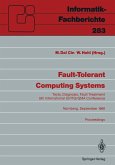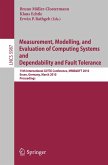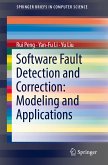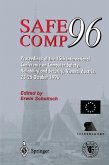Software Fault Tolerance (eBook, PDF)
Achievement and Assessment Strategies
Redaktion: Kersken, Manfred; Saglietti, Francesca
72,95 €
72,95 €
inkl. MwSt.
Sofort per Download lieferbar

36 °P sammeln
72,95 €
Als Download kaufen

72,95 €
inkl. MwSt.
Sofort per Download lieferbar

36 °P sammeln
Jetzt verschenken
Alle Infos zum eBook verschenken
72,95 €
inkl. MwSt.
Sofort per Download lieferbar
Alle Infos zum eBook verschenken

36 °P sammeln
Software Fault Tolerance (eBook, PDF)
Achievement and Assessment Strategies
Redaktion: Kersken, Manfred; Saglietti, Francesca
- Format: PDF
- Merkliste
- Auf die Merkliste
- Bewerten Bewerten
- Teilen
- Produkt teilen
- Produkterinnerung
- Produkterinnerung

Bitte loggen Sie sich zunächst in Ihr Kundenkonto ein oder registrieren Sie sich bei
bücher.de, um das eBook-Abo tolino select nutzen zu können.
Hier können Sie sich einloggen
Hier können Sie sich einloggen
Sie sind bereits eingeloggt. Klicken Sie auf 2. tolino select Abo, um fortzufahren.

Bitte loggen Sie sich zunächst in Ihr Kundenkonto ein oder registrieren Sie sich bei bücher.de, um das eBook-Abo tolino select nutzen zu können.
This volume summarizes the results obtained by the group working on software fault tolerance within the ESPRIT project REQUEST (Reliability and Quality of European Software Technology). A generic model is developed for evaluating the reliability of fault-tolerant software systems.
- Geräte: PC
- ohne Kopierschutz
- eBook Hilfe
- Größe: 20.06MB
Andere Kunden interessierten sich auch für
![Fault-Tolerant Computing Systems (eBook, PDF) Fault-Tolerant Computing Systems (eBook, PDF)]() Fault-Tolerant Computing Systems (eBook, PDF)72,95 €
Fault-Tolerant Computing Systems (eBook, PDF)72,95 €![Safe Comp 97 (eBook, PDF) Safe Comp 97 (eBook, PDF)]() Safe Comp 97 (eBook, PDF)72,95 €
Safe Comp 97 (eBook, PDF)72,95 €![Measurement, Modelling, and Evaluation of Computing Systems and Dependability in Fault Tolerance (eBook, PDF) Measurement, Modelling, and Evaluation of Computing Systems and Dependability in Fault Tolerance (eBook, PDF)]() Measurement, Modelling, and Evaluation of Computing Systems and Dependability in Fault Tolerance (eBook, PDF)40,95 €
Measurement, Modelling, and Evaluation of Computing Systems and Dependability in Fault Tolerance (eBook, PDF)40,95 €![Coloured Petri Nets (eBook, PDF) Coloured Petri Nets (eBook, PDF)]() Kurt JensenColoured Petri Nets (eBook, PDF)48,95 €
Kurt JensenColoured Petri Nets (eBook, PDF)48,95 €![Software Fault Detection and Correction: Modeling and Applications (eBook, PDF) Software Fault Detection and Correction: Modeling and Applications (eBook, PDF)]() Rui PengSoftware Fault Detection and Correction: Modeling and Applications (eBook, PDF)40,95 €
Rui PengSoftware Fault Detection and Correction: Modeling and Applications (eBook, PDF)40,95 €![High-level Petri Nets (eBook, PDF) High-level Petri Nets (eBook, PDF)]() High-level Petri Nets (eBook, PDF)40,95 €
High-level Petri Nets (eBook, PDF)40,95 €![Safe Comp 96 (eBook, PDF) Safe Comp 96 (eBook, PDF)]() Safe Comp 96 (eBook, PDF)40,95 €
Safe Comp 96 (eBook, PDF)40,95 €-
-
-
This volume summarizes the results obtained by the group working on software fault tolerance within the ESPRIT project REQUEST (Reliability and Quality of European Software Technology). A generic model is developed for evaluating the reliability of fault-tolerant software systems.
Dieser Download kann aus rechtlichen Gründen nur mit Rechnungsadresse in A, B, BG, CY, CZ, D, DK, EW, E, FIN, F, GR, HR, H, IRL, I, LT, L, LR, M, NL, PL, P, R, S, SLO, SK ausgeliefert werden.
Produktdetails
- Produktdetails
- Verlag: Springer Berlin Heidelberg
- Seitenzahl: 243
- Erscheinungstermin: 6. Dezember 2012
- Englisch
- ISBN-13: 9783642847257
- Artikelnr.: 53098795
- Verlag: Springer Berlin Heidelberg
- Seitenzahl: 243
- Erscheinungstermin: 6. Dezember 2012
- Englisch
- ISBN-13: 9783642847257
- Artikelnr.: 53098795
- Herstellerkennzeichnung Die Herstellerinformationen sind derzeit nicht verfügbar.
1 Introduction.- 2 Overview.- 2.1 The Concept of Software Fault-tolerance.- 2.2 Failure Dependence.- 2.3 Evaluation of Reliability of Fault Tolerant Software.- 2.4 Adjudication Mechanisms.- 2.5 Conclusion.- References.- 3 Considerations on Software Diversity on the Basis of Experimental and Theoretical Work.- 3.1 The Different Failure Sets of a Two-fold Diverse System.- 3.2 Experimental Approach.- 3.3 Theoretical Approach.- 3.4 Additional Requirements.- 3.5 Comparison Between Single and Diverse Use of Programs.- 3.6 Conclusion.- References.- 4 The Impact of Forced Diversity on the Failure Behaviour of Multiversion Software.- 4.1 Introduction.- 4.2 Common Failure Behaviour of Forced and Unforced Diverse Systems w. r. t. the Voter Majority.- 4.3 Common Failure Behaviour of Forced and Unforced Diverse Systems w. r. t. the Voter Granularity.- 4.4 Conclusion.- References.- 5 Functional Diversity.- 5.1 Introduction.- 5.2 Limitations of Normal Diversity.- 5.3 Description of Functional Diversity Methodology.- 5.4 Advantages of Functional with respect to Normal Diversity.- 5.5 Disadvantages of Functional Diversity.- 5.6 Application Fields.- 5.7 Choice of the Modelling Approach for Functional Diversity.- 5.8 Classical Semantic Approach.- 5.9 Functional Semantics.- 5.10 Semantic Modelling of Functional Diversity.- 5.11 Functional Diversity Metrication.- 5.12 Definition of Functional Diversity Metrics.- 5.13 Classification of the Metrics.- 5.14 Reliability Analysis for Functionally Diverse Systems.- 5.15 Static Specification Analysis.- 5.16 Reliability Evaluation.- 5.17 Semantic Specification Language.- 5.18 Semantic Specification Analysis Methodology.- References.- 6 Estimation of Failure Correlation in Diverse Software Systems with Dependent Components.- 6.1 Introduction.- 6.2 Evaluation of the Inaccuracy Resulting from the Independence Assumption.- 6.3 The Case of Available Failure Observations.- 6.4 The Case of No Available Failure Observations.- 6.5 Conclusion.- References.- 7 Measurement of Diversity Degree by Quantification of Dissimilarity in the Input Partition.- 7.1 Input Partition and Coverage Diversity.- 7.2 Partition Diversity during the Testing Phase.- 7.3 Conclusion.- References.- 8 Comparison of Mnemonics for Software Diversity Assessment.- 8.1 The Initial Prototype Investigation.- 8.2 Enhancement of the Prototype.- 8.3 Further Improvements to Technique.- 8.4 Conclusions.- References.- 9 The FRIL Model Approach for Software Diversity Assessment.- 9.1 Software Attributes Affecting Diversity.- 9.2 Measuring Diversity.- 9.3 The FRIL Model for Software Diversity Assessment.- 9.4 Extension of the Work.- References.- 10 Reliability Evaluation.- 10.1 Introduction.- 10.2 State of The Art of Reliability Models for Fault Tolerant Software.- 10.3 System States of Fault Tolerant Architectures.- 10.4 Analysis of System Sub-states.- 10.5 Modelling Approach.- 10.6 Modelling Methods.- 10.7 Evaluation of the Equations.- References.- 11 The Impact of Voter Granularity in Fault-Tolerant Software on System Reliability and Availability.- 11.1 Definition of System States.- 11.2 Effect of Voter Granularity on System States.- 11.3 Examples.- 11.4 Strategic Choice of Optimal Granularity.- 11.5 Mixed Solutions.- 11.6 Conclusion.- References.- 12 A Theoretical Evaluation of the Acceptance Test in Recovery Block Programming.- 12.1 Introduction.- 12.2 General Features and Examples of Acceptance Tests.- 12.3 Formal Definition of Acceptance Test Characteristics.- 12.4 An Error Model for the Acceptance Test Behaviour.- 12.5 Conclusion.- References.- 13 Locationof Checkpoints by Considering Information Reduction.- 13.1 Introduction.- 13.2 Failure Masking.- 13.3 Function Classes Reducing Information.- 13.4 Impact of Information Reduction on Failure Dependence.- 13.5 Information Reduction for Binary Values.- 13.6 Location of Checkpoints.- 13.7 Example.- 13.8 Conclusion.- References.- 14 Conclusions.- 14.1 Hardware Failure vs. Software Failure.- 14.2 Diversity and the Design of Fault-tolerant Software Systems.- 14.3 Assessment of Software Fault-tolerance.- 14.4 Prospect.
1 Introduction.- 2 Overview.- 2.1 The Concept of Software Fault-tolerance.- 2.2 Failure Dependence.- 2.3 Evaluation of Reliability of Fault Tolerant Software.- 2.4 Adjudication Mechanisms.- 2.5 Conclusion.- References.- 3 Considerations on Software Diversity on the Basis of Experimental and Theoretical Work.- 3.1 The Different Failure Sets of a Two-fold Diverse System.- 3.2 Experimental Approach.- 3.3 Theoretical Approach.- 3.4 Additional Requirements.- 3.5 Comparison Between Single and Diverse Use of Programs.- 3.6 Conclusion.- References.- 4 The Impact of Forced Diversity on the Failure Behaviour of Multiversion Software.- 4.1 Introduction.- 4.2 Common Failure Behaviour of Forced and Unforced Diverse Systems w. r. t. the Voter Majority.- 4.3 Common Failure Behaviour of Forced and Unforced Diverse Systems w. r. t. the Voter Granularity.- 4.4 Conclusion.- References.- 5 Functional Diversity.- 5.1 Introduction.- 5.2 Limitations of Normal Diversity.- 5.3 Description of Functional Diversity Methodology.- 5.4 Advantages of Functional with respect to Normal Diversity.- 5.5 Disadvantages of Functional Diversity.- 5.6 Application Fields.- 5.7 Choice of the Modelling Approach for Functional Diversity.- 5.8 Classical Semantic Approach.- 5.9 Functional Semantics.- 5.10 Semantic Modelling of Functional Diversity.- 5.11 Functional Diversity Metrication.- 5.12 Definition of Functional Diversity Metrics.- 5.13 Classification of the Metrics.- 5.14 Reliability Analysis for Functionally Diverse Systems.- 5.15 Static Specification Analysis.- 5.16 Reliability Evaluation.- 5.17 Semantic Specification Language.- 5.18 Semantic Specification Analysis Methodology.- References.- 6 Estimation of Failure Correlation in Diverse Software Systems with Dependent Components.- 6.1 Introduction.- 6.2 Evaluation of the Inaccuracy Resulting from the Independence Assumption.- 6.3 The Case of Available Failure Observations.- 6.4 The Case of No Available Failure Observations.- 6.5 Conclusion.- References.- 7 Measurement of Diversity Degree by Quantification of Dissimilarity in the Input Partition.- 7.1 Input Partition and Coverage Diversity.- 7.2 Partition Diversity during the Testing Phase.- 7.3 Conclusion.- References.- 8 Comparison of Mnemonics for Software Diversity Assessment.- 8.1 The Initial Prototype Investigation.- 8.2 Enhancement of the Prototype.- 8.3 Further Improvements to Technique.- 8.4 Conclusions.- References.- 9 The FRIL Model Approach for Software Diversity Assessment.- 9.1 Software Attributes Affecting Diversity.- 9.2 Measuring Diversity.- 9.3 The FRIL Model for Software Diversity Assessment.- 9.4 Extension of the Work.- References.- 10 Reliability Evaluation.- 10.1 Introduction.- 10.2 State of The Art of Reliability Models for Fault Tolerant Software.- 10.3 System States of Fault Tolerant Architectures.- 10.4 Analysis of System Sub-states.- 10.5 Modelling Approach.- 10.6 Modelling Methods.- 10.7 Evaluation of the Equations.- References.- 11 The Impact of Voter Granularity in Fault-Tolerant Software on System Reliability and Availability.- 11.1 Definition of System States.- 11.2 Effect of Voter Granularity on System States.- 11.3 Examples.- 11.4 Strategic Choice of Optimal Granularity.- 11.5 Mixed Solutions.- 11.6 Conclusion.- References.- 12 A Theoretical Evaluation of the Acceptance Test in Recovery Block Programming.- 12.1 Introduction.- 12.2 General Features and Examples of Acceptance Tests.- 12.3 Formal Definition of Acceptance Test Characteristics.- 12.4 An Error Model for the Acceptance Test Behaviour.- 12.5 Conclusion.- References.- 13 Locationof Checkpoints by Considering Information Reduction.- 13.1 Introduction.- 13.2 Failure Masking.- 13.3 Function Classes Reducing Information.- 13.4 Impact of Information Reduction on Failure Dependence.- 13.5 Information Reduction for Binary Values.- 13.6 Location of Checkpoints.- 13.7 Example.- 13.8 Conclusion.- References.- 14 Conclusions.- 14.1 Hardware Failure vs. Software Failure.- 14.2 Diversity and the Design of Fault-tolerant Software Systems.- 14.3 Assessment of Software Fault-tolerance.- 14.4 Prospect.







